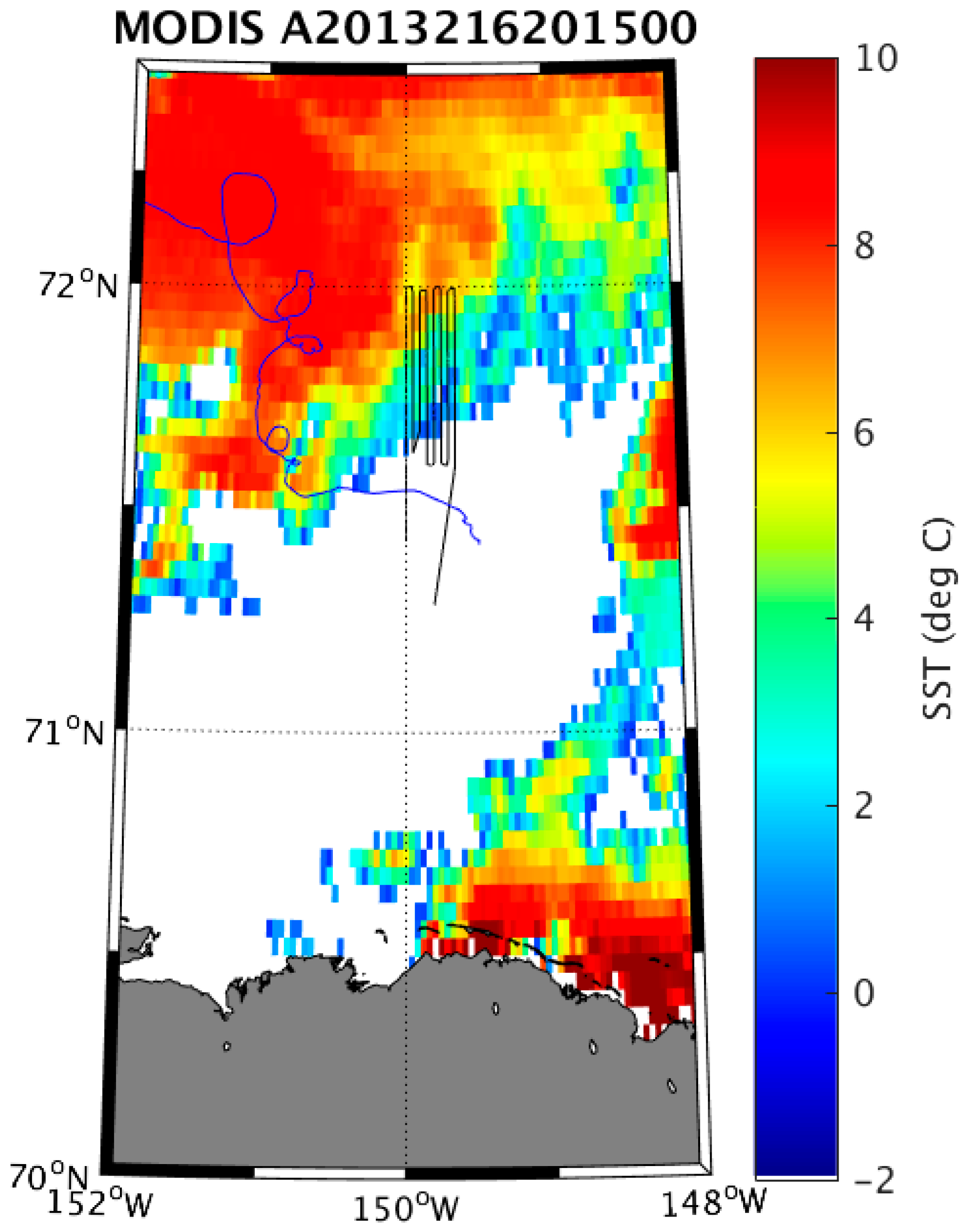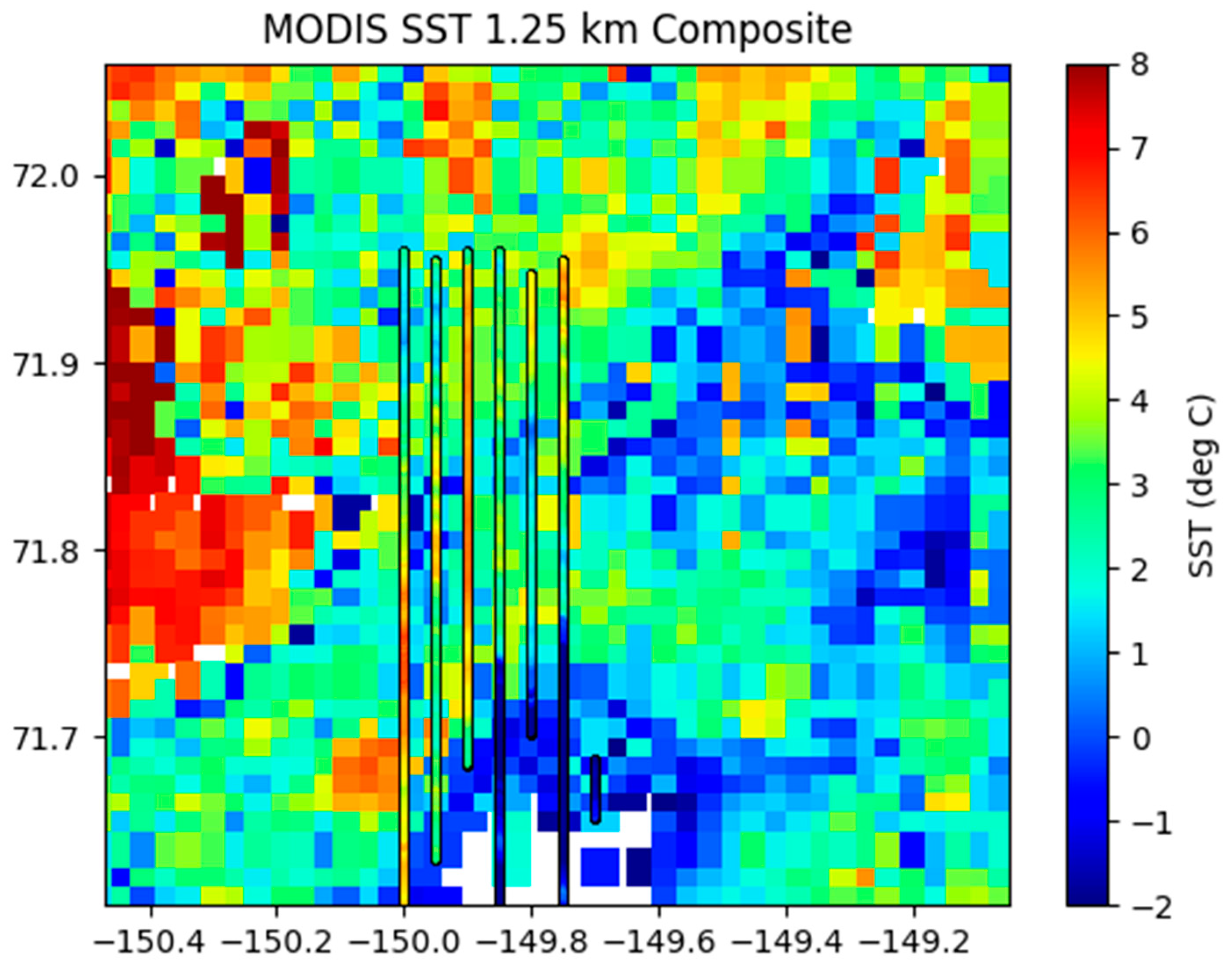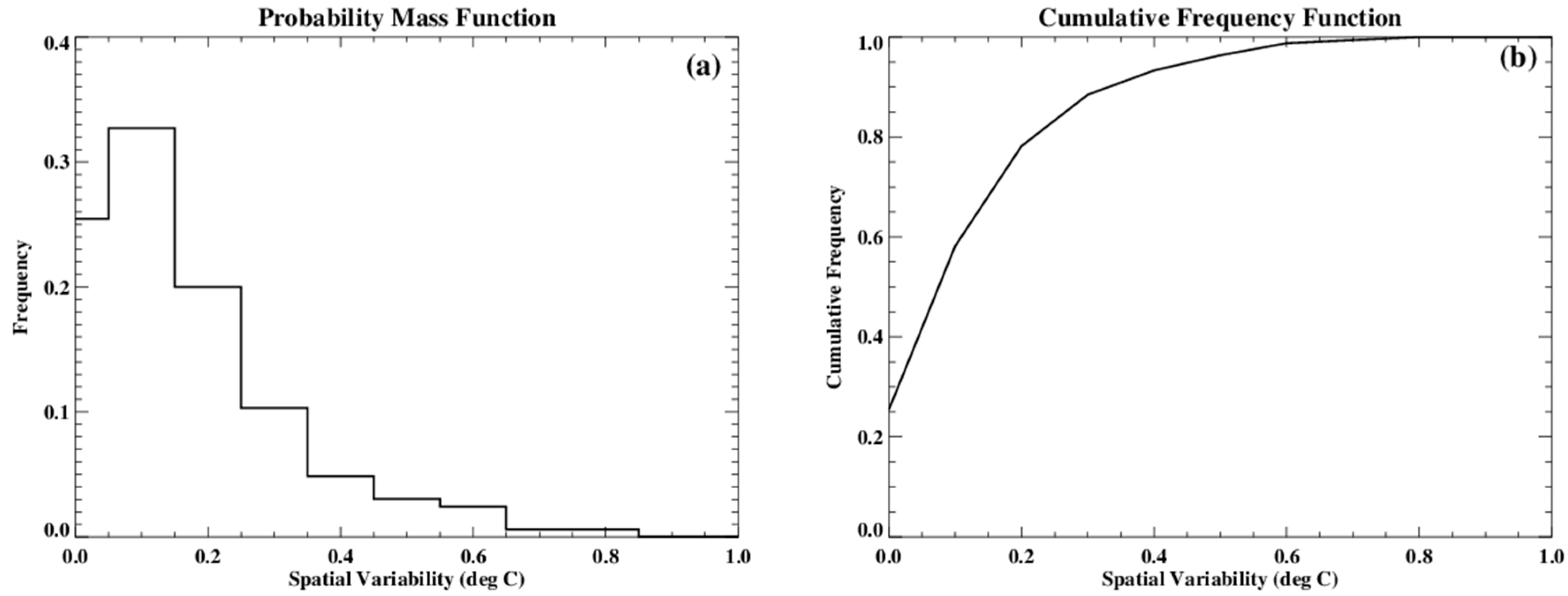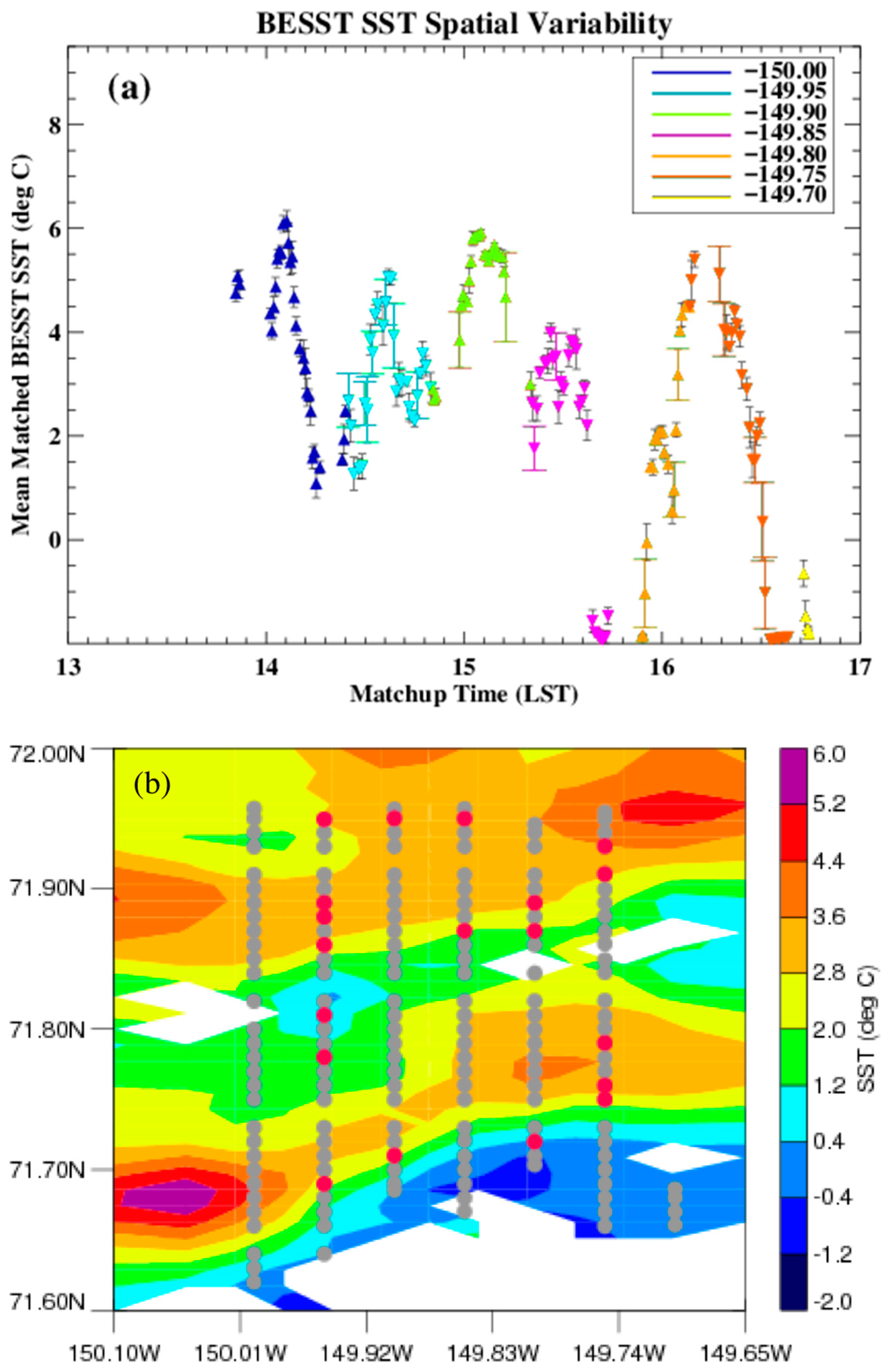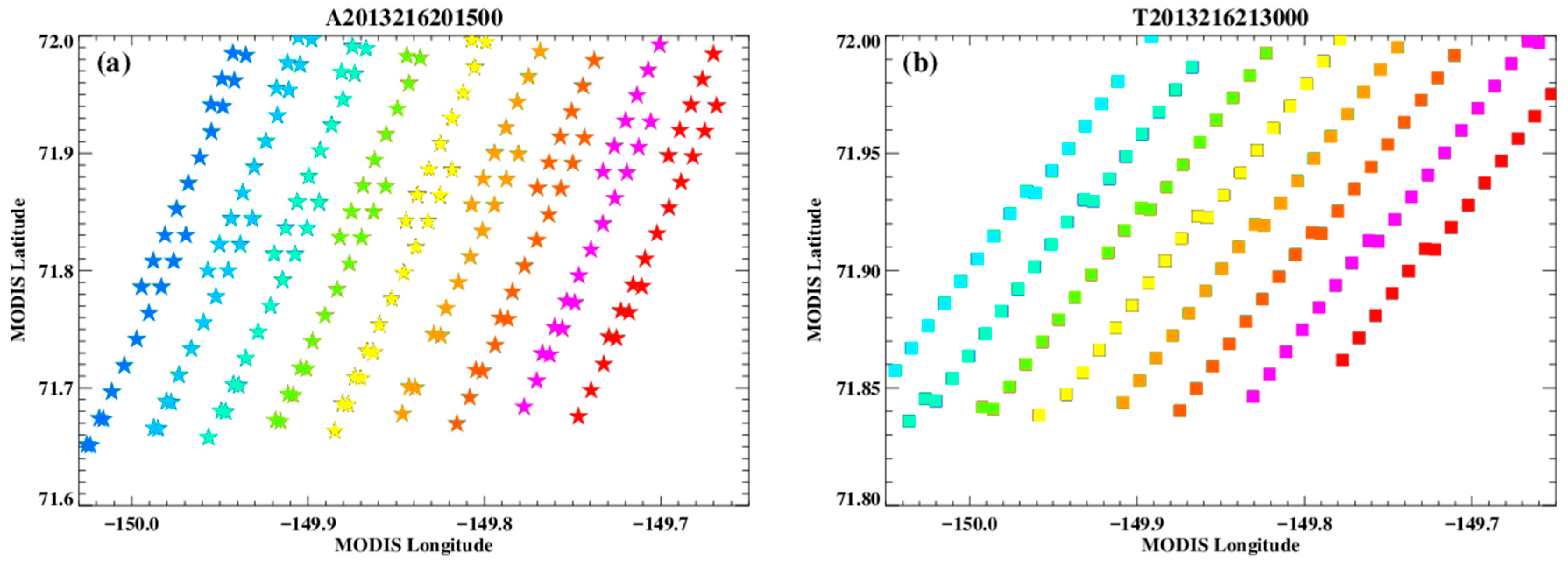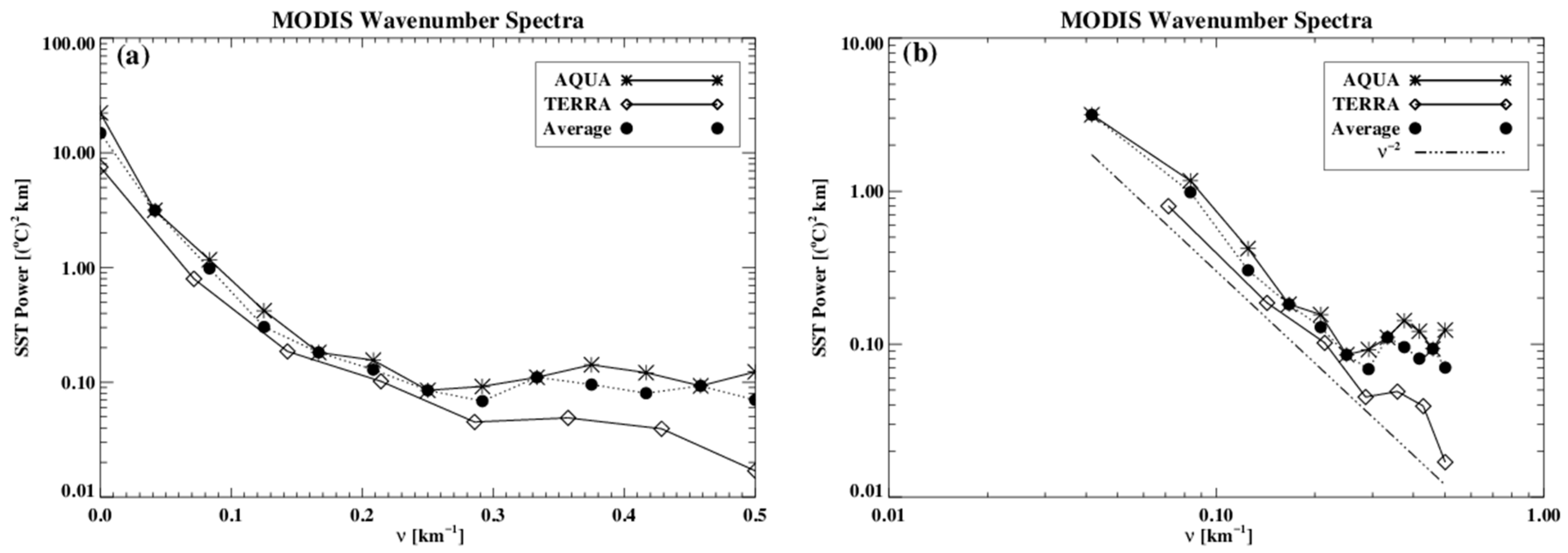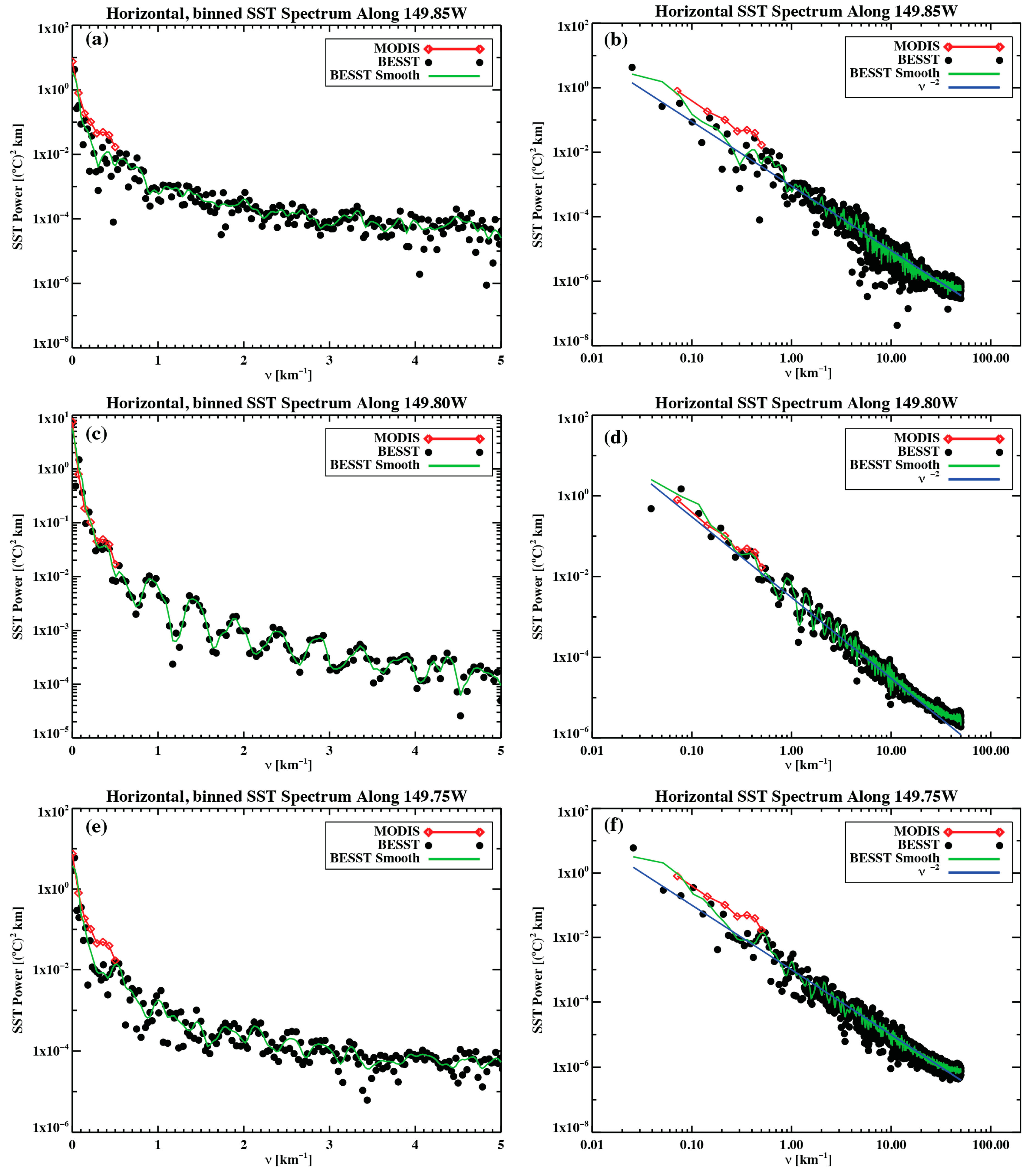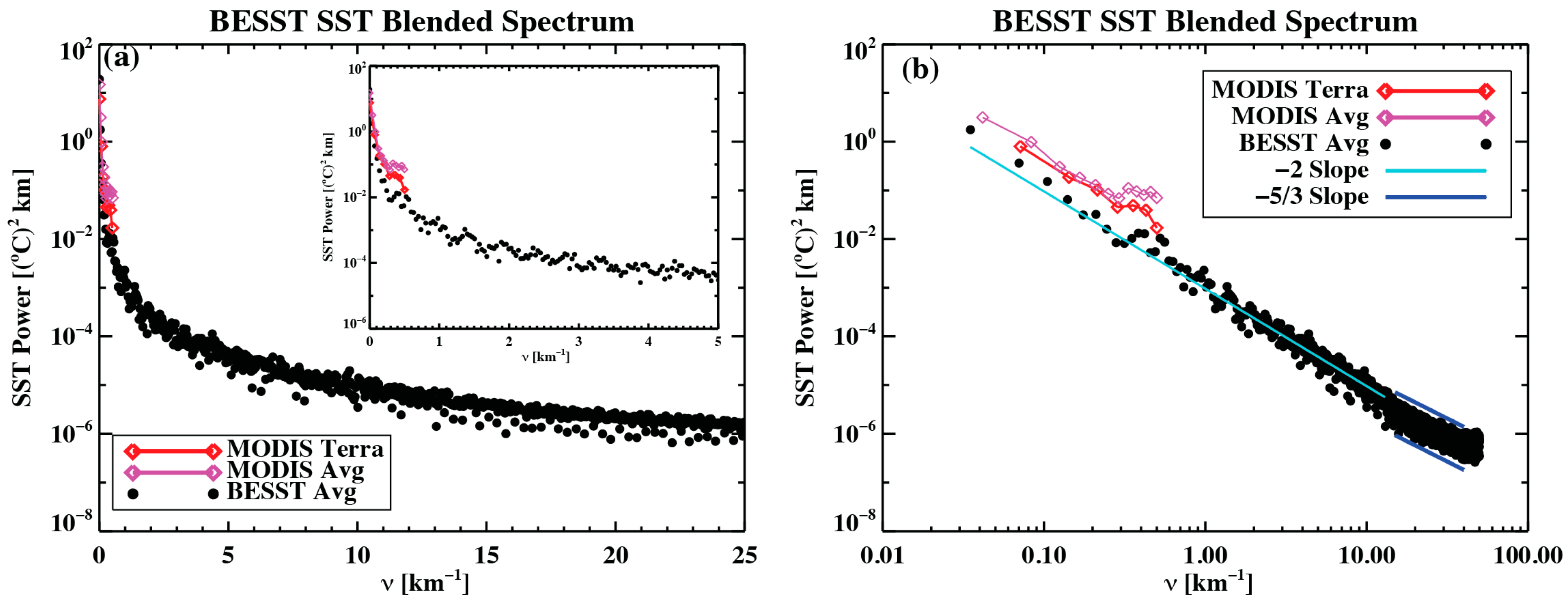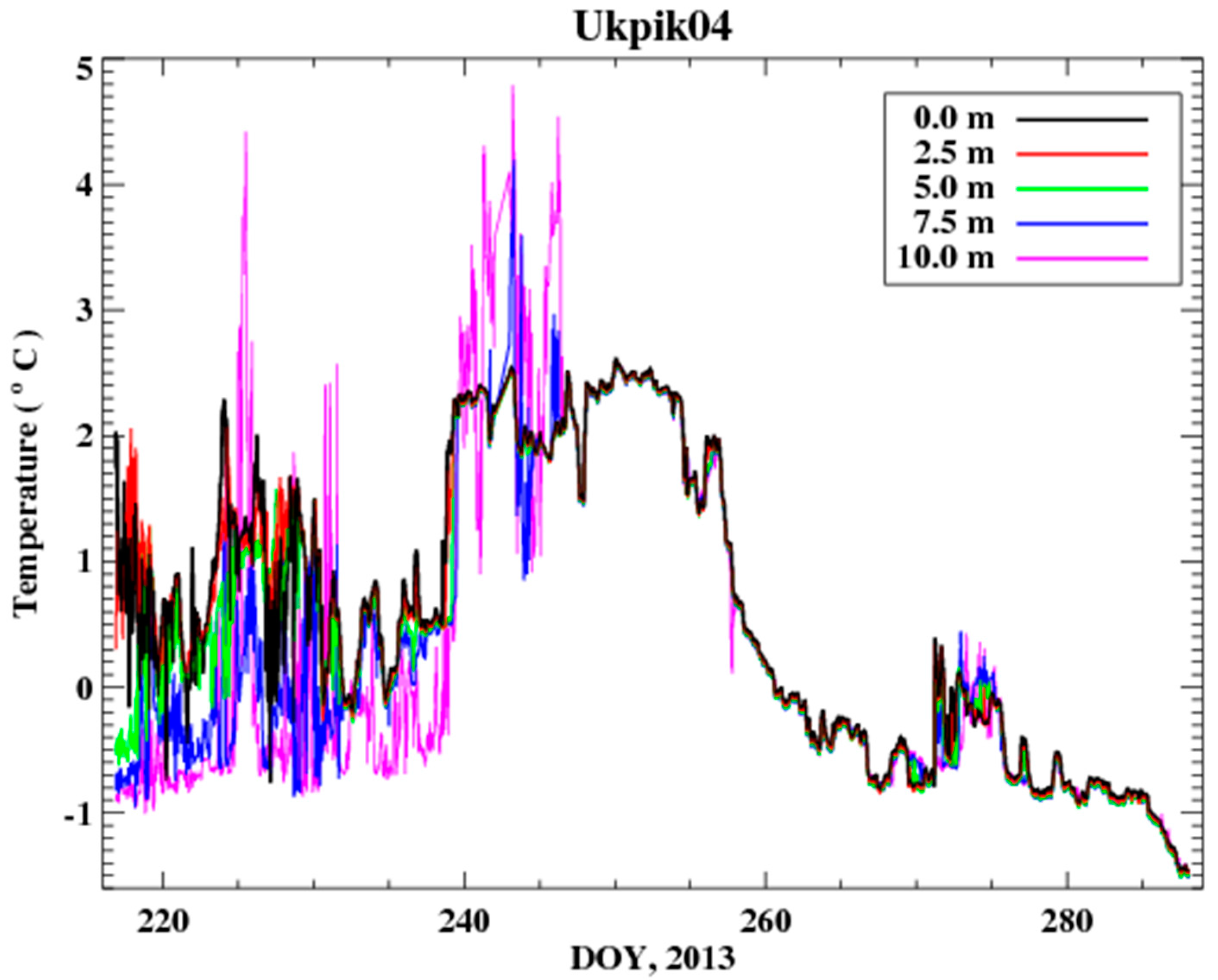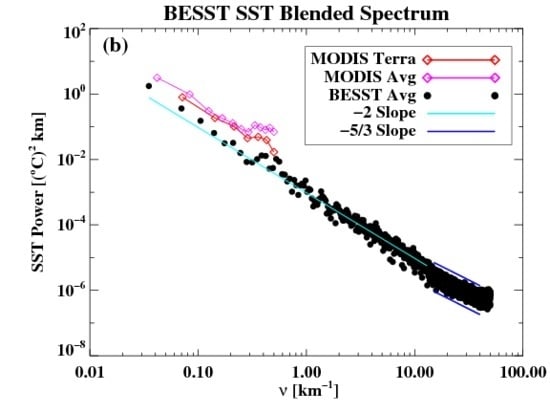4.1. Spatial Variability
Since the goal of this paper is to see whether the BESST measurements provide accurate information about the sub-pixel variability within 1-km footprints, we look at the BESST SST variations within the MODIS grid. The metric of choice is the standard deviation, σ, of the BESST measurements that fall within an individual MODIS pixel. The standard deviation is used to estimate sub-pixel variability, because it gives a measure of the dispersion (variation) of the SSTs along 1.25-km flight line segments, as the aircraft flies over an area the size of the MODIS pixel. This analysis could have been done independently of the satellite just by binning the entire BESST record using a bin width, or horizontal grid point spacing that encompasses the scales of interest. The reason we concentrated on the subset of BESST measurements paired with MODIS is to be able to use the satellite SSTs as reference for interpreting features in the variability gathered from the BESST. The normalized frequency distribution (or probability mass function, PMF) for the sample standard deviations of BESST SST within MODIS pixels is shown in
Figure 4. The frequency distribution of σ is right-skewed, with a peak value of
O(0.1) K, and a long right tail extending to a maximum of 0.8 K. The corresponding cumulative density function (CDF) shows that 95% of the pixels had σ < 0.45 K. It is interesting to note that the sub-pixel variability of this magnitude is comparable to the 0.4 K accuracy requirement for operational satellite SSTs, as cited by the Group for High Resolution Sea Surface Temperature (GHRSST) (e.g., Table 6.1 in the recommended GHRSST data specification document [
19]). If the MODIS retrieval were to be validated against a point or very high spatial resolution measurement, temperature variability within the satellite pixel alone could cause differences equal to the required accuracy. The satellite minus validation difference would not accurately reflect the uncertainty in the satellite retrieval itself. In this manner, sub-pixel variability becomes a relevant component of the total uncertainty budget when satellite retrievals are validated against observations of finer resolution. The peak value of
O(0.1) K in the sub-pixel variability corresponds very well to the uncertainty contribution from spatial variability found by [
15] for in situ skin SSTs measured with state-of-the art IR radiometers deployed from ships.
A long-tailed probability distribution can be interpreted as a statistical expression of intermittency or patchiness in the spatial and temporal distribution of submesoscale structures in the ocean surface [
9]. This intermittency is manifested in the instantaneous patterns of surface temperature, density, and vorticity. Unfortunately, the 2D BESST images were reduced to linear transects of data to dampen the noise in the microbolometer, and thus, any visual indication of SST intermittency was significantly degraded. In order to look at where the high variability SST patches occurred, we looked instead at the time series of binned, MODIS-matched, BESST SSTs (
Figure 5). From the collocation procedure described above, these are area-binned SSTs that result from averaging all of the BESST temperatures within 1.25-km cells, which are coincident with the MODIS grid. The triangles in
Figure 5a correspond to the mean SSTs within the 1.25-km pixels of the MODIS MVC. Once again, the color of the triangles indicates the flight transect. The vertex of the triangles points to the flight direction of the UAV. Error bars correspond to 1-σ noise levels of the BESST measurements within the pixels. These error bars are a graphic representation of the spatial variability within the pixel. Colored error bars indicate grid cells where the standard deviation exceeded 0.4 K. Interestingly, the preferred location of pixels with high spatial variability was at the start and end of the meridional transects (
Figure 5a).
To investigate whether the spatial distribution of high-variability pixels coincided with places of strong ocean dynamics, we looked at a contour map of the MODIS SST MVC shown in
Figure 3, with the survey domain enlarged (
Figure 5b). White areas are gaps in coverage due to clouds in the MODIS data. The dots show the location of the BESST matchups. Red dots indicate pixels where the standard deviation of the 1.25-km averaged BESST SSTs reflects the spatial variability in excess of the SST accuracy requirement of 0.4 K (i.e., where point-to-pixel differences can comprise a significant portion of inferred SST uncertainty estimates). The SST contour levels reveal a likely icy patch at the southern edge of the survey (water at freezing temperature), followed by alternating warm and cold filaments at mid-range and a warm area in the top third of the survey domain. There appears to be multiple surface vortices/eddies present in the warm patches of water. With the exception of the red dots at the northern end of the transects along −149.95°, −149.90°, and −149.85° longitude, which appear to be related to the aircraft turning 90 degrees, all other high-variability pixels are located at or near regions with strong temperature gradients. If, as the evidence suggests, the area of interweaving warm and cold waters corresponds to the MIZ, then the transition zones at the ice edge and at the open water edge of the MIZ are where the high variability took place. The high-variability patches at the bottom end of the survey, in particular, align extremely well with the thermal front (there is an SST change of roughly 3.5 °C over 10 km) that marks the transition between the icy patch and the warm filament. This is consistent not only with long tail statistics [
9], but also with horizontal density/temperature gradients (fronts) being a primary source of submesoscale intermittency near the surface (e.g., Thomas et al. [
1]; Boccaletti et al. [
8]; and Samelson and Paulson [
20]). To look for more statistical evidence that the asymmetric distribution of the SST sub-pixel variability in the MIZ is the result of a submesoscale transition regime that develops near horizontal temperature gradients, we did some spectral analysis of the SST, which is shown next.
4.2. Spectral Analysis of SSTs
When dealing with spatial variability, one has to deal with the concept of “scale”. In order to look at the spatial scales resolved by each of the IR radiometers, we next estimate the horizontal wavenumber spectra, for the BESST and the MODIS SSTs, using fast Fourier transforms. This methodology is appropriate to look at the scale content of oceanic variability, since the data were sampled at a regular interval. We emphasize that the spectra shown below are representative of the horizontal SST variance at the surface of the ocean (0 m depth), as both MODIS and BESST instruments have penetration depths on the order of 10–20 microns, which corresponds to the skin temperature of the ocean.
The MODIS SST horizontal wavenumber spectra were evaluated directly from the satellite swath data, as the level 2 product (geolocation is given in original satellite scan line/spot geometry) has higher spatial resolution than the MODIS maximum-value composite. Only the granules from the 20:15-Aqua and the 21:30-Terra overpasses were used in this analysis, as the other two lacked the complete data coverage and spatial continuity needed for a spectral analysis. The satellite wavenumber spectra are computed in the satellite along-track direction.
Figure 6a,b show the portions of the MODIS scans over the survey area for the two granules considered. The Aqua granule covers an area approximately 250-km wide across-track by 400 km along-track, which is twice as much as the Terra granule. The dots indicate the center location of the 1-km pixels and the colors identify the selected scan spots, from successive scan lines, used to estimate the individual spectra. The sequence of successive scan spots was mostly complete over the survey domain, but in the few instances where there were gaps, these were interpolated by averaging the nearest neighbors to the selected scan spot.
The wavenumber spectra from the individual along-track scan spots were binned to a common wavenumber, ν, scale and band-averaged to obtain a blended wavenumber spectrum representative of their collective distribution in space. The selected wavenumber bandwidth was ∆ν = 0.0417 km
−1 (or 24 km) for Aqua, and ∆ν = 0.0714 km
−1 (or 14 km) for Terra. By averaging over wavenumbers in these bandwidths, the spectral densities for each of the satellites are assumed to be approximately constant over the 14–24-km length-scale range. The blended spectrum is a smooth spectral density estimate that is penalized by a loss in wavenumber resolution. In other words, we cannot resolve wavelengths finer than half the corresponding wavelength (i.e., ~7–8 km).
Figure 7 shows the resulting blended spectra for the Aqua and Terra granules, in km
−1, in both semi-log and log–log scales. An Aqua–Terra ensemble-averaged wavenumber spectrum for MODIS is also shown in
Figure 7.
The logarithm of the MODIS SST spectra against wavenumber, as displayed in
Figure 7a, show very similar shapes for both the Aqua and Terra satellites, with a smooth exponential decay in power and no predominant peaks at the observed wavelengths. The log–log plot of the spectra (
Figure 7b) shows that both the individual and the blended spectra are very nearly proportional to
(
is horizontal wavenumber) in the range 0.04 < ν < 0.125–0.25 km
−1, which corresponds to wavelengths
between 25 and ~ 4–8 km. Near 4 km, the –2 power law breaks down, and a spectral peak appears close to
λ = 3 km (ν = 0.33 km
−1) in these three spectra, followed by a decrease toward the Nyquist wavelength (2 km). This log–log linear spectral shape with a slope of –2 is consistent with previous findings of horizontal wavenumber spectra of surface-layer temperature and density scaling as
over horizontal scales of
O(1)–
O(100) km at mid-latitudes [
20,
21,
22]. Thus, a slope of −2 in the temperature spectrum is consistent with submesoscale activity being the dominant source of the horizontal temperature variance, not only in the open oceans but, as our results suggest, in the MIZ as well. Since the total power (excluding the zero-term) will tend to equal the variance of the signal, the MODIS wavenumber spectra suggest that the source of the sub-pixel variability of satellite-derived SSTs within footprints of 1-km resolution resides in the submesoscale range. Dominant submesoscale features over the survey domain likely arise from temperature gradient production mechanisms such as frontogenesis and frontal instabilities.
The BESST wavenumber spectra were computed along individual meridional transects, and for the entire survey. A BESST wavenumber spectrum over the lawn-mower survey is possible under the assumption that the lawn-mower sampling was on a uniform grid. However, since the BESST frame separation varied in length around 10 ± 3 m, it was necessary to interpolate the BESST data onto a uniform 10-m length meridional grid before estimating the wavenumber spectrum along individual meridional transects. This grid resolution is consistent with the mean separation of the overlapping BESST frames.
Figure 8 shows the horizontal wavenumber spectra, in km
−1, of the 10-m gridded BESST data along the meridional transects 149.85°W, 149.80°W, and 149.75°W, both in semi-log (left column) and log–log scales (right column), respectively. The wavenumber spectra for the transects that are not shown are very similar to those displayed in
Figure 8. The collective MODIS Terra spectrum, in red, is also plotted for comparison. The black circles represent wavenumber spectra without any smoothing, whereas green traces depict spectra that were smoothed with a Tukey filter over 1-m length intervals. The density clustering of the circles illustrates clear determination of the BESST spectral shape for ν > ~2.5 km
−1 (
), but under determination for ν < ~1 km
−1 (i.e., for scales approaching the spatial resolution of the satellite). In all cases, the log–log plots of the spectra have a shape
(this is illustrated in
Figure 8 by the agreement between the smoothed spectrum in green and the theoretical spectrum
in dark blue) in the wavenumber range 0.04 < ν < 40 km
−1 (25 km >
> 0.025 km). A spectral slope of −2, once again, is a signature of submesoscale activity driving the surface temperature variability. The BESST spectrum extends the submesoscale range (10 km–100 m) at the finer wavelength resolutions an order of magnitude higher than most previously reported (from 100 m to ~25 m). A flattening of the slope occurs at ν ~40 km
−1 (
~25 m), as the scales approach what can be resolved at the BESST resolution; thus, the change in slope might just reflect noise in the BESST data or aliasing of overlapping BESST measurements.
The spectral slopes of BESST and MODIS show excellent agreement despite the BESST spectra being less resolved at the low wavenumber end where both spectra overlap. Interestingly enough, the low wavenumber end of the semi-log spectrum along 149.80°W is indistinguishable from the MODIS Terra spectrum shown in red, with both spectra showing the same shape, featuring a spectral peak at 3 km (
Figure 8c). This is surprising given the different nature of the instruments. The other two spectra (
Figure 8a,e) show a broad peak around 1.5 km, outside the MODIS domain. In these two cases, the spectral levels between the two vary by roughly half a decade. A key aspect of this comparison is that the BESST high-resolution SST data spans the spectral slope of −2 by ~3 decades in
relative to MODIS, from 8 km to 25 m. This result, in a sense, validates the satellite findings. Since step functions also have Fourier transforms proportional to
[
20], the MODIS behavior could possibly be interpreted as an artifact due to the presence of sharp fronts (the spectral slope of −2 in MODIS breaks down at 8 km, whereas the MODIS composite indicates the presence of frontal widths of ~10 km). However, the
behavior from BESST persisting to sufficiently small scales where fronts do not resemble step functions corroborates that the spectral behavior observed by both instruments is not an artifact due to the presence of sharp fronts (step functions). Instead, it is an artifact from the secondary circulations associated with fronts where submesoscales are found to occur. In essence, the BESST instrument expands the
behavior resolved by the satellite well beyond the range of horizontal scales (by at least a decade in
) required to capture the submesoscales (
according to Kunze et al. [
23]).
For a blended BESST horizontal wavenumber spectrum representative of the whole survey area, the wavenumber spectra from the individual meridional transects were binned into non-overlapping, sequential wavenumber bands of width Δν = 0.0286 km
−1 (or equivalently, Δ
λ = 35 km). In a manner consistent with the procedure used to derive the MODIS blended spectra, the ensemble-averaged BESST wavenumber spectrum for the survey domain was defined as the bin-wise average of the Fourier coefficients from the spectra from the six individual, uniformly gridded, lawn-mower transects. The ensemble waveband-average BESST wavenumber spectrum representative of the spatial domain is shown in
Figure 9. The spectral distribution shown here is qualitatively very similar to the ones in
Figure 8 for the individual transects, although they are also smoother due to the loss of wavenumber resolution resulting from the binning process. However, the low wavenumber end of the spectrum is better resolved, as it shows an offset of less than 0.5 decades in spectral power with respect to the MODIS spectra in the overlapping range. The log–log spectrum (black dots) in
Figure 9b has a shape of
in the wavenumber range 0.04 < ν < 10 km
−1 (100 m–25 km horizontal wavelengths), spanning from the small to the submesoscales, as shown by the agreement with the light blue line representing a −2 spectral slope. The shape of the spectrum confirms, once again, that a substantial portion of the variance in the SST field over the 0.04- to 10-km
−1 band is likely due to submesoscale processes present in the region at the time of the survey. The small peak present in the MODIS spectra at
λ = 3 km is well resolved in the blended BESST spectrum, but appears shifted towards a slightly higher wavenumber (
λ = ~2 km).
An interesting remark is that the break in the −2 slope for the blended spectrum happens at a longer wavelength than in the individual BESST spectra (100 m vs. 25 m). The bend in the spectrum observed here at
λ = ~100 m is consistent with a transitioning regime from the submesoscale to small-scale flows. While the occurrence of this transition cannot be ascertained from the individual spectra in
Figure 8, as the bend occurs near scales where the noise becomes predominant, noise has been significantly dampened in the blended spectrum, which is shown in
Figure 9. Furthermore, the semi-log spectrum (
Figure 9a) also shows a notable decrease in the spread of spectral power with wavenumber for ν > ~10–13 km
−1 (~80–100 km). The relevant aspect is that the spectral slope changes from −2 to −5/3, as shown by the dark blue lines bracketing the second regime in
Figure 9b. The
scaling persists from ~10 < ν < 40 km
−1 (~100 m >
> 25 m). A slope of –5/3 is consistent with the Kolmogorov spectrum for microscale turbulence [
24]. Using Kolmogorov-like dimensional analyses, Obukhov [
25] and Corrsin [
26] predicted a temperature spectrum with a slope of −5/3 at the small-scale inertial range. Wavenumber spectra with two separate power law scalings have been reported [
27,
28]. If this is indeed the case, the horizontal SST variance transitions from a regime driven by submesoscale dynamics to an inertial regime driven by microscale turbulence at horizontal scales on the order of meters. However, conclusive evidence of a meaningful transition and a spectrum with dual power law scaling requires more in depth study.
